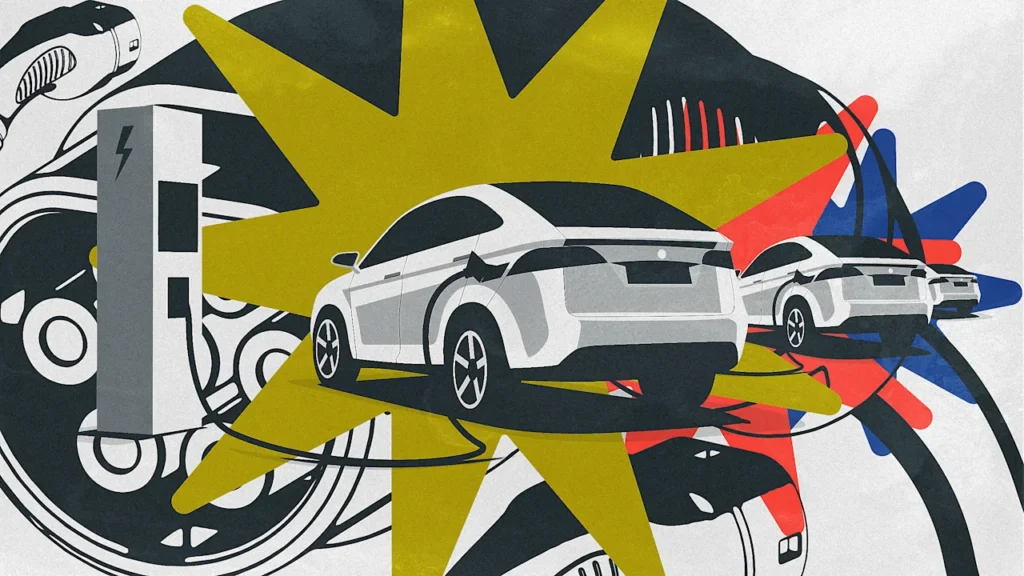
Between July and September, electric vehicle sales in the U.S. hit a record high. Americans bought more than 430,000 EVs, up 40% from the previous quarter, as they race to qualify for federal tax credits before they expire.
That EV boom wasn’t just limited to the U.S., though: Global EV sales hit an all-time high of 2.1 million in September. Two-thirds of those sales were in China, the world’s largest EV market.
And yet, there’s still talk of an “EV retreat,” both in the U.S. and abroad. Automakers have expressed concerns about their EV profits, and policymakers in Canada and the European Union are pausing, or adjusting, their EV mandates.
There’s an “inherent duality of the market moment we’re in,” says Corey Cantor, research director of the Zero Emissions Transportation Association. “On the one hand, EV sales are higher than they have ever been, and yet automakers still remain concerned.”
Here’s why, and what’s going on in the electric vehicle landscape.
EV rush before tax credits expired
EVs counted for nearly 11% of total vehicle sales in the U.S. between July and September. That’s a big increase from the same time period last year, when their share was 8.6%, according to Cox Automotive, which recently released data about the country’s third quarter EV sales.
That jump wasn’t a surprise—it was expected, experts say. Americans were rushing to buy EVs before the federal tax credits expired on September 30.
The tax credits, part of President Biden’s Inflation Reduction Act, offered up to $7,500 back for Americans who bought a new EV, if the cars they purchased met certain conditions. There was also a credit of up to $4,000 available for used EVs.
President Trump’s “One Big Beautiful Bill Act” eliminated those tax credits, killing what analysts say was a “key catalyst” for EV adoption. EVs are still seen as a “premium” purchase; in August, the average EV cost more than $57,000, according to Cox—$9,000 more than a similar gas car.
Concerns about future growth
Not every automaker benefited from all those third quarter EV sales, either. Cox Automotive notes that Mercedes-Benz EV sales in that time period were “mostly flat” year-over-year, and Toyota and Nissan sold fewer EVs during that boom than they did in the third quarter of 2024.
Despite the backlash Tesla has been dealing with throughout 2025, that carmaker actually saw an 8% sales increase year-over-year, but its share of total EV sales has fallen. Tesla once made up 49% of all EV sales in the third quarter of 2024, but its share this past quarter was 41%.
Volkswagen, General Motors, Honda, and Hyundai had notable increases in their EV sales. Volkswagen and GM’s sales were more than double the levels one year ago.
But those automakers still have concerns. This week, GM said it was taking a $1.6 billion hit from changing its EV rollout in the U.S. It changed its rollout in part because of Trump’s elimination of the tax credits, and his move to loosen emissions regulations.
These policies make the future far less certain for automakers. “Federal policies could tighten again in a couple of years or remain the same,” Cantor says. “The federal policy pathway is far less clear moving forward than it was a year ago.”
One thing experts do expect is that U.S. EV sales will slump after this quarter, because that surge to purchase before the tax credits expired “pulled forward” sales that would have been spread out over more time. Cox Automotive forecasts that EV sales will “drop notably” in Q4 and through the early months of 2026.
EV struggles worldwide
Changing U.S. policies aren’t only affecting the EV sales outlook here. Trump’s tariffs are also adding costs for automakers in international markets, like Canada and across the European Union.
The EU recently said it would review its 2035 target for cutting car emissions to zero. A policy note published before those talks highlighted challenges for the European car industry, “ including higher tariffs on shipments to the U.S.,” the Wall Street Journal reported, as well as low profit margins for EVs and the growth of cheaper Chinese offerings.
China has been dominating the EV market, not just in its own country but worldwide, in part because it offers extremely affordable EVs—some priced as low as $10,000.
But that could make the market oversaturated. While Chinese EV sales are increasing, that growth is happening more and more “at the expense of profitability,” the Wall Street Journal notes; more than 110 EV brands operated there in 2023, and they likely won’t all last.
Hope for the future
Even before Trump’s policies, there was talk of an EV sales slump in 2024. That’s because while sales were increasing, the rate at which they were growing slowed—a common issue for all new technologies as they vie for mainstream appeal. Early adopters drive that beginning growth, and then the industry has to figure out how to attract everyone else.
Now, changing federal policies are making that next step even more difficult. But EV experts still have hope.
“We’d expect the impact of these policy changes to be most acute during the forthcoming year,” Cantor says. “Overall, the global move towards electric vehicles continues.” The International Energy Agency said in May that it expects one in four cars sold worldwide this year to be electric.
Cox Automotive says EV sales are the future, too. “Cx Automotive continues to believe that over the long term—the next 10 years or more—sales of vehicles powered solely by internal combustion engines will continue to decline,” the company wrote in its Q3 EV sales report. “Electrified vehicles—hybrids, plug-in hybrids and pure EVs—are the future.”
We might not get to that future as fast as EV advocates hoped, though. Biden set a goal for EVs to make up 50% of all vehicle sales by 2030. Cox now says EV sales can hit 25% by then. So growth will be slower, “but certainly moving out of the ‘niche’ category,” Stephanie Valdez Streaty, director of industry insights at Cox, wrote in September.
And though the future of U.S. federal policy is up in the air, experts still say innovations will advance to help the EV market. “Continued innovation in battery technology, improved transparency in battery health and expanding infrastructure give reason for optimism,” Valdez Streaty wrote. “The road ahead will be challenging, but progress will continue.”






